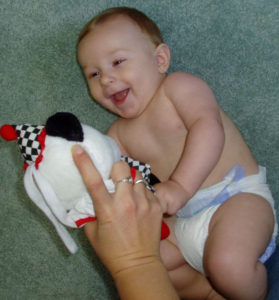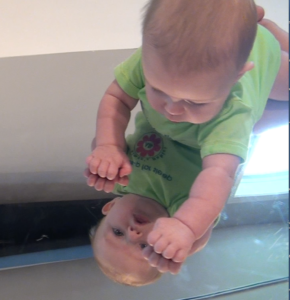
When babies are born, their vision is not completely developed. The newborn’s visual acuity is approximately 20/600, developing to 20/20 well after the age of five years in most children.

Most visual development takes place during the first six months. We consider these first six months a critical period because after that early visual development takes place, it is very difficult to make corrections.
Scientists now believe that babies only see in black and white for the first three months. Around three months of age, the cones in the eyes develop and grow longer and start to perceive different colors. The first color they are able to distinguish is red. That is why there are so many black, white, and red toys on the market for newborns.

Up until about three months babies can see objects best when they are 10-12 inches from their faces and their peripheral vision is actually more acute than straight ahead. We used to think that babies had no peripheral vision! If you look closely, you will notice that newborn babies will turn their head away from you, then look at you out of the corners of their eyes. That is not due to lack of control, they are doing that so they can see you better. Babies are so smart!
Along with visual acuity, visual motor skills (coordination of the tiny muscles around the eyes) are developing throughout the first year and both components need to be exercised simultaneously. Visual motor skills are important for scanning, reading, and catching a ball.
Build your baby’s visual skills:
- Feed your baby from alternating sides so the tiny muscles on both sides of her eyes develop symmetrically.
- Hang mirrors around his car and bassinet so he can see himself.
- Keep her visual environment novel and new so it is interesting to her.
- Move the mobile from one side of the crib to the other.
- Allow him to gaze up at your face.
- Read books and show her the pictures.
- Allow him to track by holding a toy 10-12 inches from his face, then moving it in vertical and horizontal arcs.
- Allow her to look out the window so she perceives different depths or go outside often.
- Limit screen time.
Watch this video for more great tips:
References:
Aamodt, S. & Wang, S. (2011). Welcome to Your Child’s Brain: How the Mind Grows from Conception to College. Bloomsbury, NY.
Healy, J. (1994). Your Child’s Growing Mind. A practical Guide to Brain Development and Learning From Birth to Adolescence. Doubleday.

